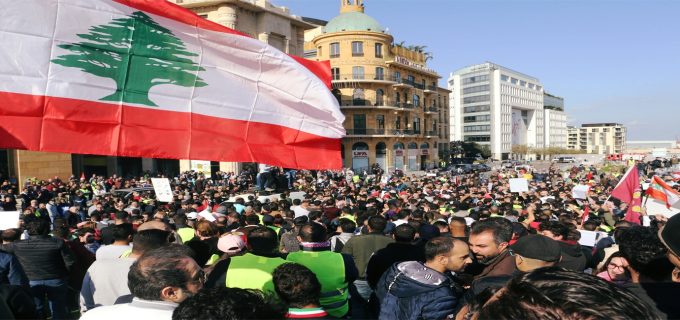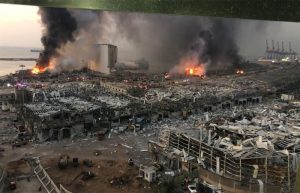The Lebanese society has been going through a state of popular movement since October 17, 2019, following the announcement of the Lebanese government of the imposition of taxes on voice calls via Internet applications (WhatsApp) at a rate of six dollars per month, as part of a series of austerity measures aimed at alleviating the financial crisis of the country.
This movement brought together various sects, Sunnis, Shiites and Christians. However, these measures did not affect the influential members of the political class, as they were mainly aimed at the predominant poor class in Lebanon. Lebanese people also bear the burdens of such measures as a consequence of corrupt government policies that have been going on for decades.
Considering Lebanon’s strategic positioning and its proximity to many important files in the region, external parties have played a major role in deepening dependence on the outside in order to maintain internal political balances, which has led to the accumulation of problems and complexities over time. This is in addition to the issue of the synchronization of the Lebanese movement with the protests in Iraq nowadays, which could heavily affect the security aspect in the region.
This situational assessment will examine the major causes of the Lebanese popular movement, the indicators of its ability to change the status of political confessionalism, and the possibility of overcoming the high corruption rates affecting the social and economic sectors.
Overview of the Lebanese Popular Movement
Whatsapp uprising, as it has been called in Lebanon, was distinguished from other previous protest movements, as it brought together Lebanese from different sects and started from different regions. Moreover, it went beyond the use of slogans adopted by the political class in the country, since there was no reference to refugees as one of the causes of the crisis. It has also overridden the sectarian dimension with its slogan: “All of them means all of them,” referring to its demand for the dismissal of the three presidents: President Michel Aoun, Prime Minister Saad Hariri and Parliament Speaker Nabih Berri. This may imply the failure of the Taif Agreement, which was particularly applied to overcome the civil war but was not aimed at creating genuine political and economic stability in the country.
This is not the first time that the Lebanese society has risen that way. Since the Arab Spring in 2011, the Lebanese have risen six times for various reasons. On February 27, 2011, popular protest movements that demanded political and economic reforms emerged, but were soon ended for fear of a sectarian divide in the country. On August 22, 2015, the “waste protests” began, as the unprecedented accumulation of waste in the streets has prompted angry Lebanese to protest on a widespread scale, accusing the government of failing and being responsible for the worsening of the case due to corruption.
Although the tax protests started on March 19, 2017, to denounce the government’s approval of a tax increase to finance the salaries of public sector employees, these demonstrations did not continue. In the same year, only six months after the previous protests, public sector employees and public school teachers went on strike to demand the adoption of the new system of salaries that was subsequently approved by Parliament. Also, protest movements were launched in April by retired military personnel who refused the amendments to their earnings and pension rights in the draft state budget for 2019.
Causes of Popular Uprising
Three reasons can be identified for the current Lebanese popular movement, most notably the economic aspect of the recent protests. According to Transparency International’s Corruption Perceptions Index, Lebanon in 2018 scored 28 out of 100 points in public sector corruption, making it one of the most corrupt countries in the region, ranking 138 globally among 180 countries. This is in addition to the severe political polarization caused by the confessionalist system adopted since the signing of the Taif Agreement in the late 1990s, which aimed to end the nearly fifteen-year civil war.
On the other hand, Lebanon was affected by its geographical proximity to the regions of regional turmoil, which led to the closure of trade with Syria, Iraq, Jordan and the Gulf countries. This has caused an economic degrowth and exposed structural problems in the Lebanese economy and its financial policies. Lebanon’s public debt now exceeds the $ 85 billion, representing 150 percent of Gross Domestic Product (GDP). Most of this debt is owed to the Lebanese banks that have wide influence on the political class But it is difficult to hold these politicians legally accountable as a result of the corruption and impartiality of the judiciary. As a result of the inability of the Lebanese government to provide basic services, such as electricity, clean water, pollution prevention, public transport, garbage collection and sorting, the movement’s demands have increased to change the whole political class for its failure.
At the social level, the confessionalist system led to the consolidation of wealth in the hands of a small group of people. An Oxfam study released earlier this year showed that seven wealthy Lebanese have a total personal wealth of $ 13.3 billion, ten times the amount that half of the Lebanese people have. Moreover, 1 percent of the Lebanese have more wealth than 58 percent of the Lebanese people. On the other hand, Confessionalism based employment system contributes to the increasing of corruption and the inability of the State to finance projects due to their random distribution based on sectarianism rather than competencies or functional need.
This is in addition to the great influence of the nature of the Lebanese political regime on the ongoing popular movement, as this regime is based on a sectarian political confessionalist system that has been implemented since the 1948 Charter, whereby the three political authorities were divided among its major sects; a Maronite President of the Republic with wide powers, a Sunni Prime Minister who goes along with him, and Shiite Speaker of the House of Representatives who manages the sessions of the Parliament.
After the continuation of the sectarian civil war in Lebanon (1975-1990), the Taif Agreement came to put an end to internal fighting and create an atmosphere of political stability. However, contrary to what was expected, this system resulted in a number of economic and social imbalances due to the distribution of positions based on sectarian loyalties rather than competencies. This resulted in negative effects at both the political and social levels, as Lebanon’s public indebtedness has risen since 2005, causing a continued political instability as a result of the inter-sectarian conflict over the sharing of resources and power, which has prevented the implementation of any effective reforms on the ground.
Position of Acting Parties
There are 18 different sects in Lebanon, but only six have a political presence, namely: Christian (Maronite, Orthodox, Catholic), Muslim (Sunni and Shia), and Druze. It is difficult to find a specific criterion for classifying these communities, but it has become very known that after the assassination of former Prime Minister Rafik Hariri, Lebanese political forces have been divided between two main alliances: the March 14 forces, with the Future Movement representing its backbone, and defending the interests of the United States and Saudi Arabia at the regional and international levels, and the March 8 forces, which include Shiite forces and some Christian currents, representing Iran’s interests in the region.
The positions of these communities have been different; some of them declared their support for the demands of the people, but others warned against the country’s fall into a new civil war with catastrophic results at the local and international levels. Among the most prominent groups that announced their support for the people’s demands are the Progressive Socialist Party led by MP Walid Jumblatt and the Lebanese Forces Party led by Samir Geagea, from which four representative ministers resigned. In contrast, none of the two ministers of the Progressive Socialist Party resigned for fear that the country would suffer from a government vacuum. Despite their different political positions, these two currents agree with the demands of the protestors; because they have both been complaining about the ignorance of their role in the current government, and they believe that the Free Patriotic Movement, Hezbollah and their allies are responsible for this.
As for the opposition parties, on top of them Hezbollah, Amal Movement, Future Movement and the Free Patriotic Movement, their position objects the uprising’s rejection of the government as a whole, as they believe that the demand to overthrow the entire political regime serves the political interests of local or foreign powers. Nevertheless, these parties affirm at the same time the legitimacy of the economic demands they have tried to achieve, but the partners, or the nature of the Lebanese regime, have prevented this, according to Hezbollah’s Secretary General Hassan Nasrallah.
Position of Lebanese Presidency and Government
Although Prime Minister Saad Hariri’s political course has been affected by the retreat of the March 14 Forces compared to the March 8 Forces due to the cessation of Saudi support for him, his desire to benefit from the current popular movement to change the balance of political forces inside Lebanon seems evident, which was clear by his rush to resign on October 29, to hold the different political parties responsible for the failure of the economic situation. This was also clear by stating that he hopes “what has happened marks the start of the end of the sectarian regime in Lebanon,” as if seeking to strengthen the Sunni presence in the political regime after being weakened against the Shiite presence. For his part, Lebanese President Michel Aoun pledged to carry out economic reforms and combat corruption, but at the same time warned against the institutional vacuum if the demonstrators insist on the departure of the three presidencies.
Despite the warning of many regional and international parties against the severeness of the deterioration of the political situation in the event of the resignation of Lebanese Prime Minister Saad Hariri, the Lebanese presidency announced on Wednesday, October 30, 2019, accepting the resignation of the government of Saad Hariri, and entrusting it with the caretaker task until the formation of a new one.
External Parties’ Positions
The UN position can be summarized by the call by its Secretary-General, António Guterres, for all political forces in Lebanon to remain calm, demanding the security forces to protect peaceful demonstrators and preserve the country’s security. On the other hand, France’s role in calming the situation was manifested in the statement of its Foreign Minister Jean-Yves Le Drian on October 29, saying that “Hariri’s resignation will exacerbate the crisis and France calls on Lebanese officials to make all their efforts to ensure the stability of institutions and the unity of the country.”
In contrast, the Iranian position criticized the Lebanese movement, which coincided with the popular movement in Iraq. The Iranian leader, Ali Khamenei held the United States and Israel responsible for the “riots and insecurity” in Iraq and Lebanon, as quoted by Iranian News Agency Tasmin on Wednesday, October 30, 2019.
Scenarios
The current Lebanese movement is distinguished by its diversity and peacefulness, which indicates its ability to continue. However, its ability to make an influence depends on its ability to organize itself and to come up with leaders – or at least its own spokespersons – to be able to overcome the stagnation and achieve its political and economic goals.
First Scenario: The Movement’s Success in Achieving Part of its Objectives
This scenario assumes the ability of the Lebanese movement to push away stagnation on the political side, which could lead to the formation of a new government not based on sectarian confessionalism, but on the competencies that may contribute to the implementation of measures to get Lebanon out of the current economic and political tension. This scenario reinforces the government’s rapid response, and the interaction of various political parties with the movement’s demands, especially after its demands turned from only achieving an economic reformation to the changing of the political regime as a whole.
Second Scenario: Aggravation of the Society Division
This scenario assumes the failure of the Lebanese movement to achieve its demands and the possibility of its fall into conflicts and skirmishes between the internal parties. This may lead to the outbreak of civil war similar to what happened before, especially since the signs of sectarian skirmishes have surfaced since the beginning of the movement, in addition to the existence of internal divisions in the movement itself over secondary issues. This is in addition to the direct threats made by Hezbollah earlier in its objection to the movement’s demands, which justifies the possibility of the outbreak of conflicts between the various Lebanese factions at home. Although there are indicators that rule out the occurrence of this scenario, such as the influence of Lebanon’s geographical location and its association with many sensitive files, this scenario is still possible to occur, given the state of political tension at the internal level, and regional conflicts at the external level.





